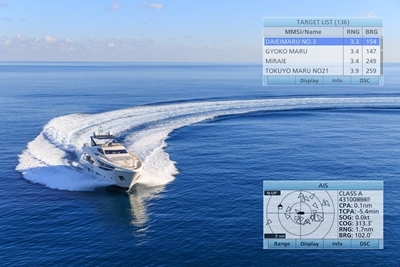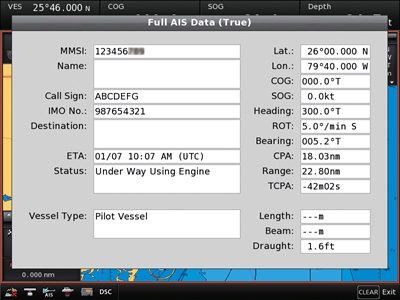What is AIS & How Does It Work?
With more and more leisure boats venturing further from their local shores, safety is paramount. Leisure boat users may be sailing in the same waters as large commercial vessels and will need to have their position and information noted to avoid any collision. This is what AIS (Automatic Identification System) does.
How AIS Works
AIS works by taking your position and movements via the vessels’ GPS system or an internal sensor built into an AIS unit. That information is then collated along with programmable information from the AIS unit (e.g. Maritime Mobile Service Identity (MMSI) number, vessel name, destination, cargo type) and is transmitted in the background at regular intervals whilst also receiving other vessels AIS information. The AIS unit can have its own separate antenna or an antenna splitter can be used from the antenna the VHF radio transmits from. If an antenna splitter is used, it must be an active splitter suitable for a VHF radio and AIS transponder.
AIS information provides an overview of every large and potential hazard transmitting via AIS relative to your own vessels’ position. This will be displayed either on a chart plotter showing the positions of the other vessels or on a radar display. Depending on the type of chart plotter or display you are using, you can have the option to select the other vessels information to view their MMSI number and call them directly through the VHF radio.
Shore based stations also have equipment that receive AIS transmitted information and display it on an electronic chart showing ‘traffic’ within the waters near them. These stations can monitor the vessels and provide added safety as they have the ability to call ships directly and warn them of potential hazards.
AIS Classification
There are 2 types of AIS classes used by ships, Class-A and Class-B.
Class-A:
This class is used by commercial ships and they operate on 12 watts while transmitting their information typically every 2 to 12 seconds (depending on speed or if at anchor) with a range of 20 miles or more if the right antenna is fitted high enough. *
Class-B:
This class is used mainly by leisure boaters and operates at a lower 2 watts, broadcasting less frequently (roughly 30 seconds) and has a range of 5 to 6 miles. *
* Transmit range only. Receiving range will vary.
Type of AIS information transmitted
AIS transponders typically transmit the following information:
• Vessel name, MMSI number and call sign
• Type of vessel (such as passenger, cargo, fishing)
• Vessel’s position (current latitude and longitude)
• Course over ground (COG)
• Speed over ground (SOG)
• Heading from your vessel
• Closest point of approach (CPA) (distance)
• Time to closest point of approach (TCPA)
• Vessels’ dimensions (length, beam and draught)
Please note, type of information transmitted may differ from Class-A and Class-B transponders.
Other Uses For AIS:
AIS has uses other than just for collision prevention. Fishing fleets can contact other vessels within their vicinity to warn of trailing fishing nets and suggest course corrections to avoid entanglement.
AIS can be used in personal locator beacons for members of a ship’s crew. If a crew member was to fall overboard then a small transmitter worn by the crew would activate. Their boat or another vessel will then see the bearing and distance to the person in the water as the AIS information will be displayed on their navigational equipment.
Also, anyone can track ships via AIS on the internet via such sites like
http:/www.marinetraffic.com. On a commercial side, ship managers can track their fleet of ships when at sea. On a leisure side, a relative or friend of a person who is sailing could arrange to meet up at a port or marina close to their current position or just check on their progress.
Conclusion
AIS is very reliable as it transmits the GPS location including SOG and COG. AIS also transmits a boats’ specific MMSI number and the vessels name allowing personal contact by Digital Selective Calling (DSC), avoiding vague descriptions (e.g. “ship off my port bow”). This can help to give warnings of close proximity or course corrections. Where visibility is low, AIS can be a great aid as it works like a real time radar offering safety in these dangerous conditions.
AIS is a benefit to anyone sailing and Icom offers several AIS solutions.
The
IC-M94DE is the first handheld marine radio in the world that offers users receive information broadcast by other AIS-equipped vessels. The IC-M94DE, which also includes DSC, provides vessel traffic information shown on the radios large clear display. With its elegant design and abundance of simple to use features, this is a game-changing device for anyone who ventures out to sea for recreation or work.
Also available is Icom's new compact, waterproof
MA-510TR Class B AIS transponder.
This all in one standalone unit combines transponder and display in a smart, compact design featuring an attractive 4.3 inch wide-angled colour TFT display which is easy to read, even under direct sunlight. This advanced AIS transponder features a whole host of important collision risk management functions as well as a navigation function that guides the operator to their destination.
Icom also offers the
IC-M605EURO VHF/DSC radio which feature AIS receive only technology. This radio integrate via the NMEA2000 data network providing seamless operation and real-time AIS traffic information and DSC individual calling. The radio also feature the ‘Danger List’ function which helps you find any dangerous target whose CPA is within 6 nautical miles and TCPA is within 60 minutes of your vessel.
Another solution, if you are looking for a fixed marine VHF radio solution with AIS Receiver, is the
IC-M510E VHF/DSC Marine Radio (AIS Receiver Version). In addition to many features, this model comes with Smartphone Control via the RS-M500 App. Its standard version, the
IC-M510 VHF/DSC radio can be combined with a Digital Yacht product called the AIT2500 Class B AIS transponder that will create a combined VHF/DSC/Class B+ AIS transponder solution. This solution would be ideal for a small boat like a RIB or sports boat with limited dash space. More details about this solution can be found here:
'Convert your IC-M510E into a Combined Marine VHF/DSC Radio/Class B + Transponder Solution with Digital Yacht'.
Should you have any questions or want further advice about our range, contact our team at
sales@icomuk.co.uk or 01227 741741.



